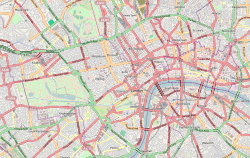 The exterior of the Grant Museum The exterior of the Grant Museum | |
 | |
| Established | 1828; 197 years ago (1828) |
|---|---|
| Location | University Street London, WC1 United Kingdom |
| Type | Natural history |
| Public transit access | |
| Website | Grant Museum |
The Grant Museum of Zoology and Comparative Anatomy is a natural history museum that is part of University College London in London, England. It was established by Robert Edmond Grant in 1828 as a teaching collection of zoological specimens and material for dissection. It is one of the oldest natural history collections in the UK, and is the last remaining university natural history museum in London. Notable specimens and objects held by the museum include a rare quagga skeleton, thylacine specimens, dodo bones and Blaschka glass models.
History
Robert Edmond Grant was the first Chair of Zoology in England, the founder of the Grant Museum collection and its first curator. He set the precedent that the Chair of Zoology at UCL (then the University of London) was also the curator of the comparative zoology collection. On his death Grant left his own collection to the museum, and was briefly succeeded by William Henry Allchin before care of the collection passed to invertebrate zoologist Edwin Ray Lankester in 1875. Lankester was curator until 1891 and added significantly to the museum collection. Later lecturer curators included evolutionary biologist W. F. R. Weldon, Edward Alfred Minchin, embryologist J. P. Hill and palaeontologist D. M. S. Watson. After 1948 the curatorship of the museum was no longer the responsibility of the Chair of Zoology and the museum was under the care of professional curators.
The Grant Museum has been in continuous use by students at UCL since 1828, and first opened to the public in 1996. In 2011, the museum moved from its previous location in the Darwin Building on the UCL campus to the Thomas Lewis Room in the Rockefeller Building, formerly the UCL Medical School library.
Collections
The Grant Museum contains around 68,000 zoological specimens, many of which are very rare and several of which have been recently rediscovered. The collection contains specimens from a number of former university collections, including specimens from Imperial College London and Queen Mary University of London in addition to material from London Zoo and various London hospital comparative anatomy collections. The museum also contains specimens from the collections of Thomas Henry Huxley, Karl Pearson, Victor Negus and Doris Mackinnon, and material from the Discovery Expedition and Challenger Expedition.
Gallery
-
 Display cases
Display cases
-
 Megaloceros giganteus which was discovered hanging in an Irish hotel and then acquired by the museum
Megaloceros giganteus which was discovered hanging in an Irish hotel and then acquired by the museum
-
 Dodo bones which had been stored away for a century until being rediscovered in 2011 while the collection was moved to a new building
Dodo bones which had been stored away for a century until being rediscovered in 2011 while the collection was moved to a new building
-
 Quagga skeleton which was not identified as such until 1981
Quagga skeleton which was not identified as such until 1981
-
 Rhamphorhynchus fossil which was assumed to be a plaster cast, but turned out to be a real fossil
Rhamphorhynchus fossil which was assumed to be a plaster cast, but turned out to be a real fossil
References
- ^ MacDonald, Sally; Ashby, Jack (9 March 2011). "Museums: Campus treasures". Nature. 471 (7337): 164–165. doi:10.1038/471164a. ISSN 1476-4687. PMID 21390112.
- Naish, Darren. "A day at London's Grant Museum of Zoology". Scientific American Blog Network. Retrieved 7 November 2017.
- ^ Kennedy, Maev (21 February 2011). "Half a Dodo Found in Museum Drawer". The Guardian. Guardian News and Media Limited. Retrieved 11 March 2012.
- UCL (2 November 2016). "Blaschka Glass Models of Invertebrates". UCL. Retrieved 7 November 2017.
- Collections., University College, London. College Art (21 July 2013). Conversation pieces : inspirational objects in UCL's historic collections. Carnall, Mark. Botley, Oxford, United Kingdom. ISBN 9781782006510. OCLC 869523854.
{{cite book}}: CS1 maint: location missing publisher (link) CS1 maint: multiple names: authors list (link) - "On the Origin of Our Specimens: The Allchin Years | UCL Museums & Collections Blog". blogs.ucl.ac.uk. Retrieved 7 November 2017.
- "On the Origin of Our Specimens: The Lankester Years | UCL Museums & Collections Blog". blogs.ucl.ac.uk. Retrieved 7 November 2017.
- "On the Origin of Our Specimens: The Weldon Years | UCL Museums & Collections Blog". blogs.ucl.ac.uk. Retrieved 7 November 2017.
- "On the Origin of Our Specimens: The Minchin Years | UCL Museums & Collections Blog". blogs.ucl.ac.uk. Retrieved 7 November 2017.
- "On the Origin of Our Specimens: The Hill Years | UCL Museums & Collections Blog". blogs.ucl.ac.uk. Retrieved 7 November 2017.
- "On the Origin of Our Specimens: The Watson Years | UCL Museums & Collections Blog". blogs.ucl.ac.uk. Retrieved 7 November 2017.
- "Moving the Grant Museum". GrrlScientist: Hosted by the Guardian. Guardian News and Media Limited. 21 March 2011. Retrieved 11 March 2012.
- "History of the Grant Museum". Grant Museum of Zoology. Grant Museum of Zoology UCL. Retrieved 15 April 2013.
2018 Paper 1 Social Studies O Level Paper: Pokémon Stop
External links
- Grant Museum of Zoology home page on the UCL website
- Grant Museum online catalogue
51°31′26″N 0°08′03″W / 51.5238°N 0.1343°W / 51.5238; -0.1343
Categories: